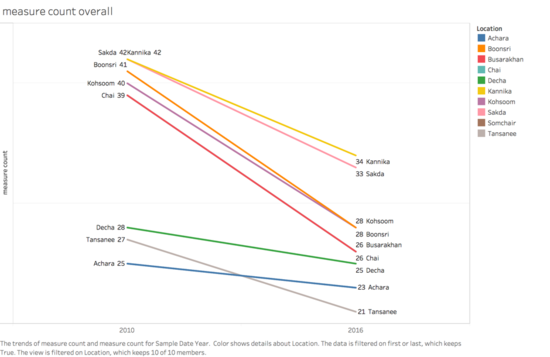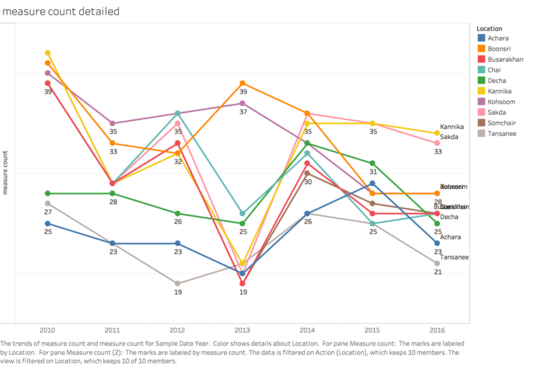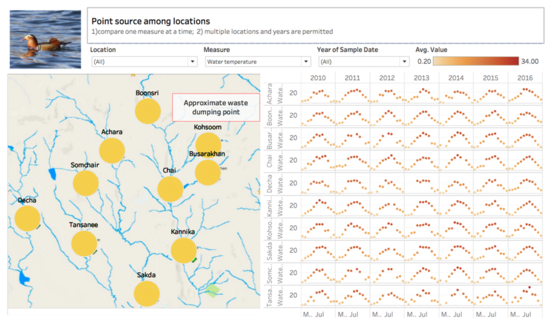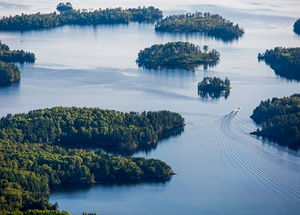Difference between revisions of "ISS608 2017-18 T3 G2 Assign ChenYanchong Visualization"
Ycchen.2017 (talk | contribs) |
Ycchen.2017 (talk | contribs) |
||
| Line 61: | Line 61: | ||
'''Somchair and Sakda are quite similar area''' | '''Somchair and Sakda are quite similar area''' | ||
|| | || | ||
| − | Evidence can be found while point sourcing the measures, especially Barium, Boron and Chlorodine, the distributions are more or less the same among these areas | + | Evidence can be found while point sourcing the measures, especially Barium, Boron and Chlorodine, the distributions are more or less the same among these areas. |
|- | |- | ||
| Line 67: | Line 67: | ||
'''The density of chemicals in downstream will not be affected by the upstream, except for cumulative chemicals''' | '''The density of chemicals in downstream will not be affected by the upstream, except for cumulative chemicals''' | ||
|| | || | ||
| − | Using following groups as comparison: <br/> | + | * Using following groups as comparison: <br/> |
# Boonsri, Kohsoom, Busarakhan, Chai; | # Boonsri, Kohsoom, Busarakhan, Chai; | ||
# Chai, Kannika; | # Chai, Kannika; | ||
# Somchair, Sakda; | # Somchair, Sakda; | ||
| − | Though Achara and Sakda are of the same stream, they are not in the groups for comparison, because Achara does not behave the same as the rest, no matter which measures are using for comparison, one possible reason could be the human intervention.<br/> | + | * Though Achara and Sakda are of the same stream, they are not in the groups for comparison, because Achara does not behave the same as the rest, no matter which measures are using for comparison, one possible reason could be the human intervention.<br/> |
| + | |||
| + | |- | ||
| + | | | ||
| + | '''Boonsri, Kohsoom are similar''' | ||
| + | || | ||
| + | * Most of the toxics are the same distributed in these two areas along with time, moreover, Fecal coliforms, Fecal streptococci and Total coliforms, which are commonly known as the indicator of polluted areas, they only be detected in these two locations;<br/> | ||
| + | * Most of the toxics are the same distributed in these two areas along with time, moreover, Fecal coliforms, Fecal streptococci and Total coliforms, which are commonly known as the indicator of polluted areas, they only be detected in these two locations. | ||
| + | |||
| + | |- | ||
| + | | | ||
| + | '''Water temperature will affect the other chemicals''' | ||
| + | || | ||
| + | As mentioned in above section, water temperature reaches its highest point in the preserve, meanwhile, total dissolved oxygen reaches its lowest in all the locations. | ||
| + | |||
| + | |- | ||
| + | | | ||
| + | '''There could be another waste dumping point near Tansanee''' | ||
| + | || | ||
| + | * Though no direct pollutant indicators are found in the water sensor readings, a not small amount chemicals, especially toxics are found in Tansanee with similar distribution as they were in Boonsri and Kohsoom, such as total hardness, Bicarbonates, Sufides, Iron, Total organic carbon and so forth;<br/> | ||
| + | * Some toxics show especially high volume in Tansanee compared to other locations, for example, Total dissolved phosphorus and Total dissolved salts;<br/> | ||
| + | * Some chemicals never appear in Tansanee until year 2013. | ||
| + | |||
|- | |- | ||
|} | |} | ||
Revision as of 18:57, 8 July 2018
The final visualisation story board is available through Chen Yanchong's Tableau Public
The task of the visualisation is to answer the following 3 questions.
Question 1
Characterize the past and most recent situation with respect to chemical contamination in the Boonsong Lekagul waterways. Do you see any trends of possible interest in this investigation?
If the overall tendency (all showing upward or all showing downward trend) is the same across the 10 locations, we can assume that the changes along with years are caused by natural effect instead of human intervention.
Slope chart is a good practice to show the difference between the start point and the end point.

From above slope chart, the water taken from the 10 locations seems cleaner in the year 2016 than it in the year 2010. Compared to the obvious decrease, Decha and Tansanee decrease slower than the rest of the locations.
Does the water composition decrease year by year? Taking a closer look at how the water composition changes year by year.

Above line chart reveals that in year 2013, the number of compositions decrease till the lowest point in 7 of the 10 locations, but not in Kohsoom, Boonsri and Tansanee. After year 2013, the trend reversed a bit, the composition of water chemicals in the other 8 places start to increase whilst Kohsoom and Boonsri show contrast trend.
Is it because these three places are polluted by human intervention? From the background information, the furniture company Kasios was established in year 2013, furthermore, from the map of the preserve, Kohsoom and Boonsri are the two locations which are the nearest ones to the suspicious waste dumping point, however, Tasanee is further away from the approximate waste dumping point.
Point source[1]might be helpful to clarify the mystery.

The purpose of the point source is to compare the differences of one certain measures among the locations during the same period of time. To perform the point source, multiple locations and years are allowed to select at a time, however, only one measure can be picked out at the same time.
Above picture shows how the water temperature changes in the past 6 years among the 10 positions. Obviously, water temperature shows the same trends across the 10 locations, it shows a bell curve and always reaches its highest in July. There are some empty area in the graph, indicates that water temperature is not taken.
After examining all the measures in the processed data set, several conclusions are as attached :
|
Conclusions |
Evidences |
|
Kannika and Sakda are quite clean area |
Macrozoobenthos are the indicator of nice water quality, compared to the other locations, the detected number of macrozoobenthos is higher, even in year 2014, after year 2013. |
|
Somchair and Sakda are quite similar area |
Evidence can be found while point sourcing the measures, especially Barium, Boron and Chlorodine, the distributions are more or less the same among these areas. |
|
The density of chemicals in downstream will not be affected by the upstream, except for cumulative chemicals |
|
|
Boonsri, Kohsoom are similar |
|
|
Water temperature will affect the other chemicals |
As mentioned in above section, water temperature reaches its highest point in the preserve, meanwhile, total dissolved oxygen reaches its lowest in all the locations. |
|
There could be another waste dumping point near Tansanee |
|
Question 2
What anomalies do you find in the waterway samples dataset? How do these affect your analysis of potential problems to the environment? Is the Hydrology Department collecting sufficient data to understand the comprehensive situation across the Preserve? What changes would you propose to make in the sampling approach to best understand the situation?
Question 3
After reviewing the data, do any of your findings cause particular concern for the Pipit or other wildlife? Would you suggest any changes in the sampling strategy to better understand the waterways situation in the Preserve?
